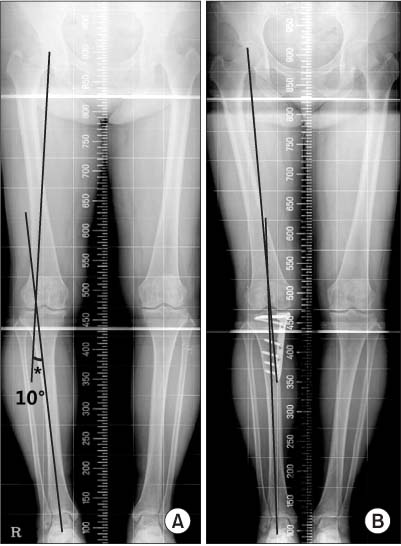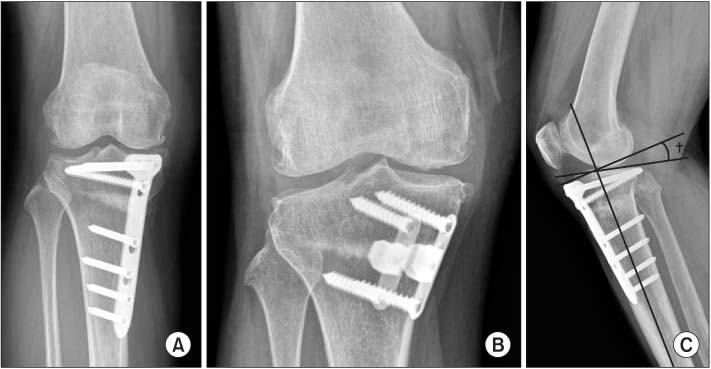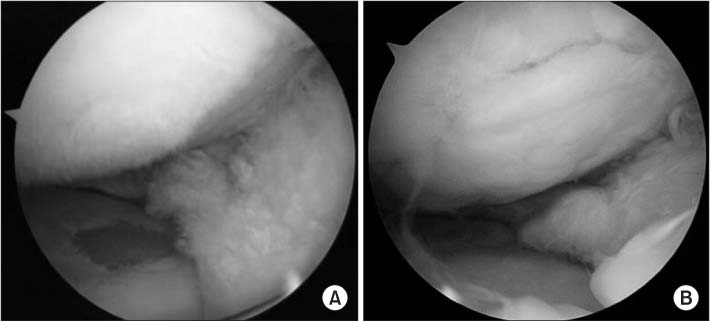J Korean Orthop Assoc.
2015 Oct;50(5):379-386. 10.4055/jkoa.2015.50.5.379.
Clinical Results after Medial Opening Wedge High Tibial Osteotomy in Medial Compartment Osteoarthritis of the Knee: TomoFix(R) versus Aescula(R) Plates
- Affiliations
-
- 1Department of Orthopedic Surgery, Chonbuk National University Medical School, Chonbuk National University Hospital Clinical Trial Center, Jeonju, Korea. hyukpark@jbnu.ac.kr
- KMID: 2185100
- DOI: http://doi.org/10.4055/jkoa.2015.50.5.379
Abstract
- PURPOSE
The purpose of this study was to compare the clinical and radiologic results of medial open wedge high tibial osteotomy (HTO) using either TomoFix(R) plate (group A) or Aescula(R) plate (group B) in patients with medial compartment osteoarthritis.
MATERIALS AND METHODS
Sixty-four consecutive patients who underwent HTO for medial compartmental osteoarthritis from 2008 were included. Mean follow-up duration was 37.1 months. Twenty men and 44 women with a mean age of 50 years (range, 41 to 62 years) were divided into group A (locking plate, n=20) and group B (spacer plate, n=44). Clinical results were evaluated using knee society rating system (KSS) and Western Ontario and McMaster Universities Osteoarthritis Index (WOMAC). Radiological results were obtained by measuring the mechanical axis, posterior tibial slope, and medial joint space width preoperatively, 3 months postoperatively, and at the final follow-up.
RESULTS
In overall patients, the mechanical axis was corrected from 7.8degrees+/-2.4degrees of varus preoperatively to 1.9degrees+/-2.2degrees of valgus 3 months after HTO. At the final follow-up, the mechanical axis was to 2.1degrees+/-3.1degrees of valgus which showed no statistical difference in group A. However, loss of correction was observed at the final follow-up, at 0.1degrees+/-3.1degrees of valgus angulation in group B. The increase of the posterior tibial slope was significantly greater in group A than group B. The joint space width in both groups was improved at last follow-up. All clinical results showed improvement after HTO, with significantly improved KSS and WOMAC scores (p<0.001).
CONCLUSION
The overall clinical results after HTO for medial compartment osteoarthritis were satisfactory. A group of spacer plates needed for prolonged protective weight bearing and locking plate was effective in maintenance of correction.
Keyword
MeSH Terms
Figure
Reference
-
1. Agneskirchner JD, Hurschler C, Wrann CD, Lobenhoffer P. The effects of valgus medial opening wedge high tibial osteotomy on articular cartilage pressure of the knee: a biomechanical study. Arthroscopy. 2007; 23:852–861.2. Floerkemeier S, Staubli AE, Schroeter S, Goldhahn S, Lobenhoffer P. Outcome after high tibial open-wedge osteotomy: a retrospective evaluation of 533 patients. Knee Surg Sports Traumatol Arthrosc. 2013; 21:170–180.3. Akizuki S, Shibakawa A, Takizawa T, Yamazaki I, Horiuchi H. The long-term outcome of high tibial osteotomy: a ten- to 20-year follow-up. J Bone Joint Surg Br. 2008; 90:592–596.4. Flecher X, Parratte S, Aubaniac JM, Argenson JN. A 12-28-year followup study of closing wedge high tibial osteotomy. Clin Orthop Relat Res. 2006; 452:91–96.5. Akizuki S, Yasukawa Y, Takizawa T. Does arthroscopic abrasion arthroplasty promote cartilage regeneration in osteoarthritic knees with eburnation? A prospective study of high tibial osteotomy with abrasion arthroplasty versus high tibial osteotomy alone. Arthroscopy. 1997; 13:9–17.6. Miller BS, Downie B, McDonough EB, Wojtys EM. Complications after medial opening wedge high tibial osteotomy. Arthroscopy. 2009; 25:639–646.7. Smith TO, Sexton D, Mitchell P, Hing CB. Opening- or closing-wedged high tibial osteotomy: a meta-analysis of clinical and radiological outcomes. Knee. 2011; 18:361–368.8. Benzakour T, Hefti A, Lemseffer M, El Ahmadi JD, Bouyarmane H, Benzakour A. High tibial osteotomy for medial osteoarthritis of the knee: 15 years follow-up. Int Orthop. 2010; 34:209–215.9. Warden SJ, Morris HG, Crossley KM, Brukner PD, Bennell KL. Delayed- and non-union following opening wedge high tibial osteotomy: surgeons' results from 182 completed cases. Knee Surg Sports Traumatol Arthrosc. 2005; 13:34–37.10. Agneskirchner JD, Freiling D, Hurschler C, Lobenhoffer P. Primary stability of four different implants for opening wedge high tibial osteotomy. Knee Surg Sports Traumatol Arthrosc. 2006; 14:291–300.11. Spahn G, Mückley T, Kahl E, Hofmann GO. Biomechanical investigation of different internal fixations in medial opening-wedge high tibial osteotomy. Clin Biomech (Bristol, Avon). 2006; 21:272–278.12. Lee SC, Jung KA, Nam CH, Jung SH, Hwang SH. The short-term follow-up results of open wedge high tibial osteotomy with using an Aescula open wedge plate and an allogenic bone graft: the minimum 1-year follow-up results. Clin Orthop Surg. 2010; 2:47–54.13. Jung WH, Chun CW, Lee JH, Ha JH, Kim JH, Jeong JH. Comparative study of medial opening-wedge high tibial osteotomy using 2 different implants. Arthroscopy. 2013; 29:1063–1071.14. Dugdale TW, Noyes FR, Styer D. Preoperative planning for high tibial osteotomy. The effect of lateral tibiofemoral separation and tibiofemoral length. Clin Orthop Relat Res. 1992; (274):248–264.15. Outerbridge RE. The etiology of chondromalacia patellae. J Bone Joint Surg Br. 1961; 43-B:752–757.16. Takeuchi R, Ishikawa H, Kumagai K, et al. Fractures around the lateral cortical hinge after a medial opening-wedge high tibial osteotomy: a new classification of lateral hinge fracture. Arthroscopy. 2012; 28:85–94.17. Hankemeier S, Mommsen P, Krettek C, et al. Accuracy of high tibial osteotomy: comparison between open- and closed-wedge technique. Knee Surg Sports Traumatol Arthrosc. 2010; 18:1328–1333.18. Stoffel K, Stachowiak G, Kuster M. Open wedge high tibial osteotomy: biomechanical investigation of the modified Arthrex Osteotomy Plate (Puddu Plate) and the TomoFix Plate. Clin Biomech (Bristol, Avon). 2004; 19:944–950.19. Niinimäki TT, Eskelinen A, Mann BS, Junnila M, Ohtonen P, Leppilahti J. Survivorship of high tibial osteotomy in the treatment of osteoarthritis of the knee: Finnish registry-based study of 3195 knees. J Bone Joint Surg Br. 2012; 94:1517–1521.20. Petrigliano FA, Suero EM, Voos JE, Pearle AD, Allen AA. The effect of proximal tibial slope on dynamic stability testing of the posterior cruciate ligament- and posterolateral corner-deficient knee. Am J Sports Med. 2012; 40:1322–1328.21. Rodner CM, Adams DJ, Diaz-Doran V, et al. Medial opening wedge tibial osteotomy and the sagittal plane: the effect of increasing tibial slope on tibiofemoral contact pressure. Am J Sports Med. 2006; 34:1431–1441.22. Chae DJ, Shetty GM, Lee DB, Choi HW, Han SB, Nha KW. Tibial slope and patellar height after opening wedge high tibia osteotomy using autologous tricortical iliac bone graft. Knee. 2008; 15:128–133.23. Asada S, Akagi M, Mori S, Matsushita T, Hashimoto K, Hamanishi C. Increase in posterior tibial slope would result in correction loss in frontal plane after medial open-wedge high tibial osteotomy. Knee Surg Sports Traumatol Arthrosc. 2012; 20:571–578.24. Amendola A, Fowler PJ, Litchfield R, Kirkley S, Clatworthy M. Opening wedge high tibial osteotomy using a novel technique: early results and complications. J Knee Surg. 2004; 17:164–169.25. Lobenhoffer P, Agneskirchner JD. Improvements in surgical technique of valgus high tibial osteotomy. Knee Surg Sports Traumatol Arthrosc. 2003; 11:132–138.26. Sterett WI, Steadman JR, Huang MJ, Matheny LM, Briggs KK. Chondral resurfacing and high tibial osteotomy in the varus knee: survivorship analysis. Am J Sports Med. 2010; 38:1420–1424.27. Matsunaga D, Akizuki S, Takizawa T, Yamazaki I, Kuraishi J. Repair of articular cartilage and clinical outcome after osteotomy with microfracture or abrasion arthroplasty for medial gonarthrosis. Knee. 2007; 14:465–471.
- Full Text Links
- Actions
-
Cited
- CITED
-
- Close
- Share
- Similar articles
-
- Biplanar Open Wedge High Tibial Osteotomy in the Medial Compartment Osteoarthritis of the Knee Joint: Comparison between the Aescula and TomoFix Plate
- Basic Principles and Current Trends of Medial Opening-Wedge High Tibial Osteotomy
- Delayed Onset of the Popliteal Artery Pseudoaneurysm Following Medial Opening Wedge High Tibial Osteotomy
- Opening Wedge High Tibia Osteotomy
- High Tibial Osteotomy




